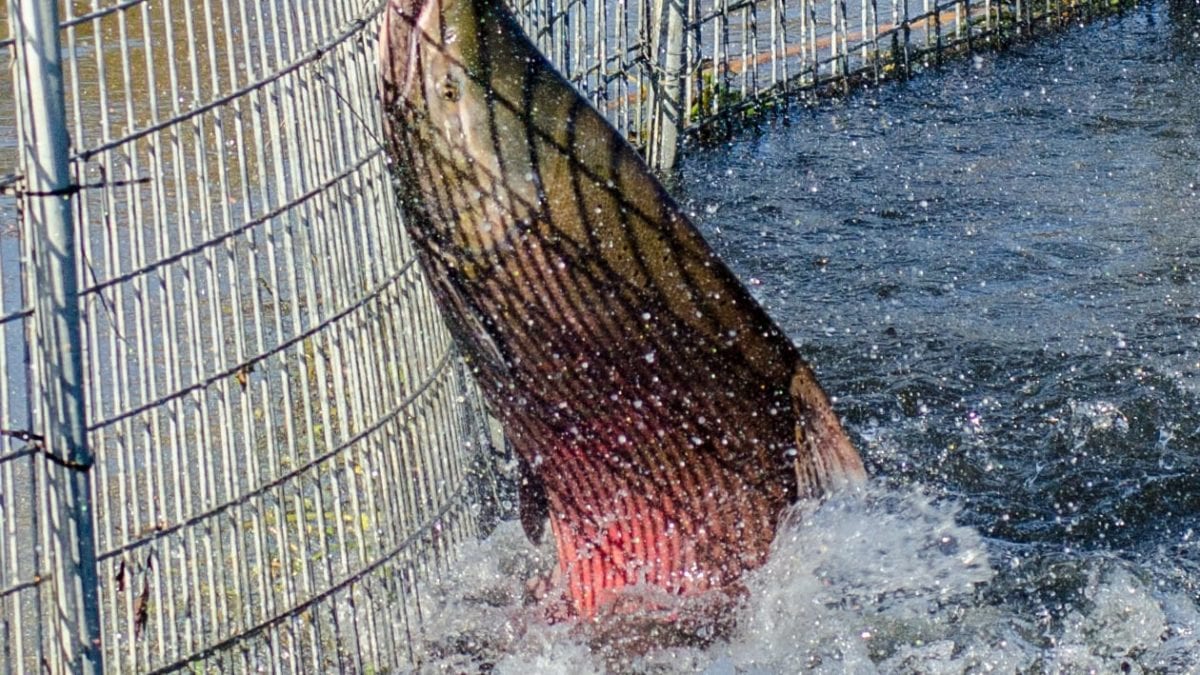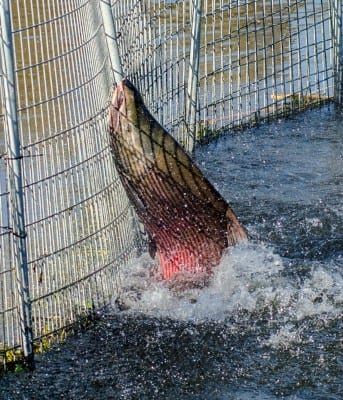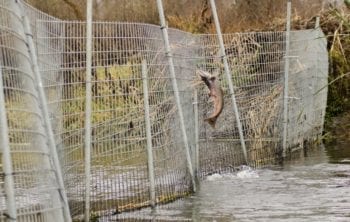Dead in the Ditch: Valley Drainage Canals are a Fatal Detour for Salmon

Proposed fix delayed by state and federal inaction
Woodland, CA — Hundreds of large salmon have taken a wrong turn into dead-end drainage ditches in the Yolo Bypass where they will perish if not rescued by the Department of Fish and Wildlife. Born in freshwater, salmon travel to the ocean to mature and then return, swimming upstream to their natal streams to reproduce. Canals, levees, dams and other water infrastructure built by people interrupt migrations and are a major factor in the dramatic decline of Central Valley salmon species, most of which are now imperiled.
“The Department of Fish and Wildlife is doing great work to help these stranded fish. But the bottom line is that this is an avoidable problem,” said Jacob Katz of California Trout, a non-profit organization that advocates for the recovery of the state’s threatened native fish. “With a small amount of focused engineering work, we could solve this problem and keep these salmon on course. Then state staff could focus their time and energy on other pressing projects.”
Ensuring that these late-arriving salmon are saved and successfully spawn is particularly important this year due to the extended drought. Elevated river temperatures caused by drought are believed to have killed many of the salmon eggs laid earlier in the fall. Only now are temperatures in upriver spawning beds near Redding cooling enough to successfully hatch salmon eggs.
“Because of the drought, saving these fish is very important. They may represent our best chance at a future generation three years from now, when this year’s salmon hatchlings will reach maturity,” said Katz.
Salmon navigate largely by smell. Because the drainage water flowing out of the canals originates in the Sacramento River basin, it can confuse salmon, luring them into drainage ditches where they become stranded and die. The number of salmon lost each year is unknown because high muddy water in winter usually makes it hard to observe fish in the canals. This year, however, low water conditions are allowing the California Dept. of Fish and Wildlife to trap the salmon and move them back to the Sacramento River to continue their spawning journey.
Fishing organizations, environmental advocates and agricultural interests have been urging state and federal agencies to make improvements that would help keep salmon in the main stem. Working together, local farmers, drainage districts and salmon advocates, including Cal Marsh and Farm, California Trout and the Golden Gate Salmon Association, have proposed a relatively easy fix to the canal system that would redirect the salmon to back to the river and safety, averting this kind of expensive rescue effort in the future.
“Salmon straying into the Yolo Bypass and the Colusa Drain is clearly a large problem and it is in everybody’s interest to fix it, plus it is not a very complicated,” said local rice farmer and land owner John Brennan. “There are only two ways into the Colusa drainage system. Both can be engineered relatively quickly and economically to prevent fish straying.”
The California Dept. of Water Resources and US Bureau of Reclamation are the two agencies with primary responsibility to fix the Valley Water infrastructure to make it better for salmon. Both agencies are working on a long term plan to restore more salmon-friendly habitat to the Yolo Bypass, where the canal and lost fish are located. These planning efforts are likely to take a decade or more. In the meantime, efforts to upgrade the canal infrastructure which was built one hundred years ago before fish were considered in project design, and solve the immediate problem of salmon being falsely attracted into the drainage canals have suffered repeated delays.
“The state and federal agencies need to address this problem now,” said John McManus of the Golden Gate Salmon Association (GGSA), a coalition representing sport and commercial salmon fishermen.
The salmon being intercepted now are believed to be fall run, but federally endangered winter and spring run salmon also swim up the canals, often to their death. In 2013 an estimated 600 winter run salmon, the most endangered of the Central Valley salmon runs, swam into the canal. About half were captured by DFW and relocated to the river but none successfully reproduced.
“If that many adult winter run salmon were caught at sea, the National Marine Fisheries Service could have shut down the $1.4 billion dollar ocean salmon fishery,” said McManus of GGSA. “If 20 percent of the offspring from these adult fish were sucked into the Delta pumps, the National Marine Fisheries Service could be forced to shut down the Central Valley and State Water Projects which provide water to millions of Californians. There is simply no excuse for allowing this problem to persist as long as it has.”
You can read the Sacramento Bee story here .
Frequently Asked Questions:
Why does it matter if a few fish don’t manage to reproduce this year?
Salmon need cold water in order to successfully reproduce. California is in its fourth year of drought. Water levels are down and water temperatures are up. Most of the fall run has already spawned. The fish at the trap now are relatively late arrivals. Ensuring that they are saved and successfully spawn is particularly important because elevated river temperatures caused by drought are believed to have killed many of the salmon eggs laid earlier in the fall. Only now are temperatures in upriver spawning beds cooling enough to successfully hatch salmon eggs.
What effect has the drought had on overall salmon populations in the Central Valley?Central Valley salmon runs are adapted to drought, and under natural conditions salmon would adapt by using the cold-water habitats where they are available. But human alteration of the valley, especially construction of dams which cut salmon off from cold water habitats and levees which limit food production on floodplains, has so degraded the river habitats on which salmon depend that most runs are now endangered. A drought of this magnitude, therefore has the potential to drive already endangered salmon runs over the brink to extinction.
How many fish have been caught and transported out of this canal to date this fall?
Over 500, mostly fall run Chinook salmon, have been captured at this one location alone in the last month. Many more are showing up each day. Endangered winter run Chinook salmon are expected to begin arriving in the coming months.
Where is the drainage canal in question located?
Beginning near Red Bluff and ending in the Delta, the network of flood protection and ag drainage canals stretches for over 100 miles down the west side of the Sacramento Valley. Attracted by the water flow coming down the canals, fish leave the Sacramento river and swim into the drainage system in the southern Yolo Bypass near Liberty Island. The trapping location, at Wallace Weir on Knaggs Ranch is 30 miles north near the town of Woodland. If the trap is not in place the salmon can continue upstream into the Colusa Drain, a maze of ditches which extend approximately 80 miles north.
What fixes have been proposed to state and federal agencies that would prevent these types of wrong turns in the future?
Local stakeholders including drainage districts, environmental conservation organizations and farmers have long advocated for a upgrading the obsolete Wallace Weir with operable gates that would block salmon and sturgeon from swimming up the canals and be good for farming.
Why haven’t these improvements been made?
The improvement projects are relatively cheap and have no detractors or opponents, there has been a lack of political will to align the local, state and federal agencies needed to actually get something done and improve the situation on the ground. DWR and the BoR, as lead state and federal agencies need to step up and build a permanent fix, rather than continue a cycle of perpetual planning.






